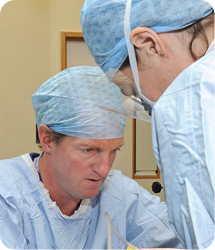Breast Unit
Breast Reduction
Breast Reduction Surgery
 Mr Richard Sutton in Theatre |
On this page: Overview The Operation Scarring What a Reduction Can & Cannot Achieve Complications Long Term Considerations Applying for NHS Funding |
Overview
The general principle of breast reduction surgery is to reduce both the skin envelope and the substance of the breast to create a smaller, more pert breast with the nipple and the areola lying higher than they currently do.
This results in significant scar formation over the breast, which is absolutely impossible to avoid. Despite this, most patients are very satisfied with what they’ve been able to achieve through breast reduction surgery and universally high levels of patient satisfaction are reported.
The operation has been shown to help many problems that are associated with having a large bust. These benefits may include:
- Improved discomfort in the upper back, shoulders and neck
- Increased ability to exercise
- Improved perception of body image
- Decreased infection in the skin underneath the crease of the breast
Please Note:
This type of surgery is available at the RUH but prior authorisation through the local Clinical Commissioning Group (CCG) is required. Please read the guidance on Applying for NHS funding
The Operation
The operation is undertaken under general anaesthetic as an inpatient. The operation takes many hours to perform (between three to five) and patients need to remain in hospital for one to two nights afterwards.
For most patients a surgical drain is placed at the time of the operation and removed 24 hours later.
Initially the breast is very swollen and pert. It may take many months before the swelling and the bruising settles, so that the patient knows what the end result may be. During this period of time most patients need to wear a soft support style type bra for comfort and to support the breast.
Most patients do not experience a great degree of post-operative pain and the pain that is experienced is normally easily controlled with simple analgesics. However, obviously the amount of pain experienced does vary considerably between patients and some may experience more than others.
Scarring
There are a number of different surgical techniques for performing the operation and each technique may leave a slightly different pattern of scars.
However, all types of breast reduction surgery result in a circular scar around the nipple and areola as well as a vertical scar that extends from the lower part of the nipple to the cease underneath the breast.
Depending on the type of technique used there may also be a long scar that runs along the length of the skin crease underneath the breast itself. Although this scar is quite long it is well hidden.
What Breast Reduction Can and Cannot Achieve
There are some important things to understand about the operation and what it can and cannot achieve.
- It is impossible to make the breasts completely symmetrical.
- It can be very difficult to predict exactly what bra size the patient will be at the end of the operation. The aim is simply to make the bust size more in proportion with the overall frame and figure of the patient.
- Many women notice altered sensation around the nipple and the areola and around the scars in the breast. The sensation is normally reduced to some extent but for some women it may actually be increased or even over sensitive.
- Most women will not be able to breast-feed after the operation.
Complications
Most patients do not develop complications following the operation, but a small percentage of patients may develop them.
Possible complications might include things like a wound infection, bleeding into the wound after the operation has finished to form a collection of blood (which might need a further operation), delayed wound healing or even partial or total loss of the nipple and the areola itself (very unlikely).
A significant number of women may develop problems with delayed wound healing at the junction of the inverted T scar (in the lower aspect of the breast). This may require surgical dressings to be in place for a number of weeks or even for further minor surgery to help wound healing.
Long Term Considerations
- Most women will not be able to breast-feed after the operation.
- With regard to breast cancer, this operation may reduce the risk of developing a breast cancer in the future.
However, if the woman is unlucky enough to develop a breast cancer in the future it might be slightly more difficult to detect due to the scar tissue that forms within the breast after the operation. - It might be slightly more difficult to feel a breast cancer on examination and it might be slightly more difficult to see a breast cancer on a mammogram.
Applying for NHS Funding
Breast reduction surgery is not routinely undertaken through the NHS, unless the patient has the operation as part of their treatment for breast cancer.
This does not imply that the operation is not performed through the NHS, just that it needs to be agreed to be funded through the local Clinical Commissioning Group (CCG) .
As long as the surgery is appropriate, the GP can make an application to the Special Exception Committee of the CCG to see if they agree to fund the operation. Only if the Committee agree to fund the operation can it proceed through the NHS. If the application is successful the operation can then be commissioned at a hospital, such as the RUH. Breast reduction surgery is an operation that is frequently performed at the RUH by our Oncoplastic Breast Surgeon.
There is National policy document produced by the Department of Health with respect to Plastic Surgery Services (incorporating operations such as breast reduction surgery). This clearly states the guidelines that should be used when evaluating eligibility for this type of surgery through the NHS.
Information for Commissioners of Plastic Surgery Services
Link to external site opens in a new window
However, it is important to understand that local guidelines may vary between individual CCGs so you will need to check what they are, either through your GP or directly through your own CCG.
There are two important considerations that your GP and CCG will need to know before considering the application for funding. These are to do with your weight and the physical symptoms that are related to having a large bust:
- Physical problems related to the bust size:
An assessment by a physiotherapist should be done to establish whether symptoms such as back ache are related to having a large bust. Of course, there may be other explanations for the discomfort and there may be alternative strategies to help without the need for breast reduction surgery.
It may be helpful to include the written report from the physiotherapist with the application to the Special Exception Committee. - The patient's weight:
It is also important to ensure that the patient's weight is not excessive. This is very important because excessive weight will increase the risks of post operative problems and complications.
The National guideline is that the body mass index (BMI) should be less than 30 kg/m2, although a lower BMI may be stipulated by certain CCGs.
Another use link produced by the Department of Health for those considering cosmetic surgery is:
Cosmetic Surgery and Non-Surgical Cosmetic Treatments
Link to external site opens in a new window


